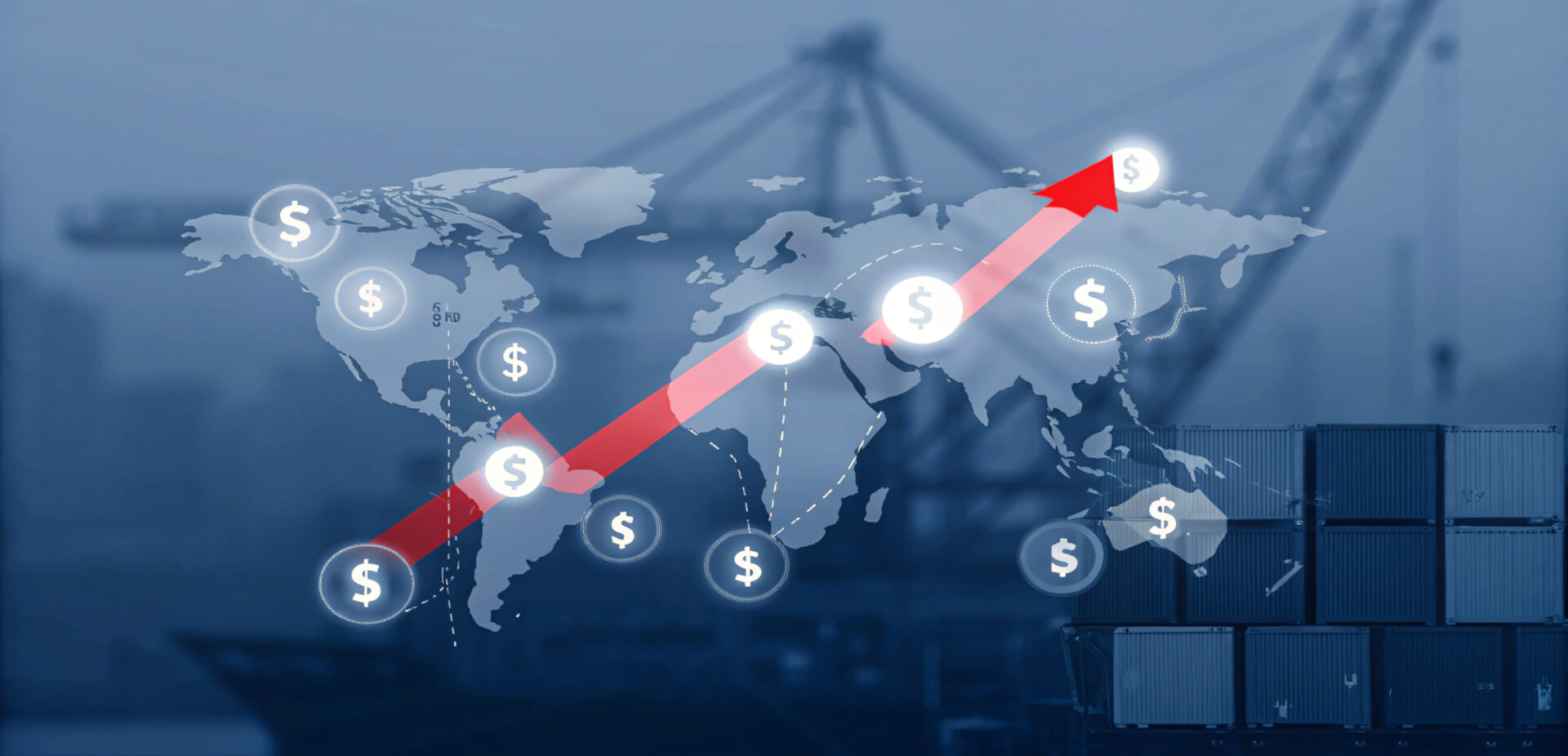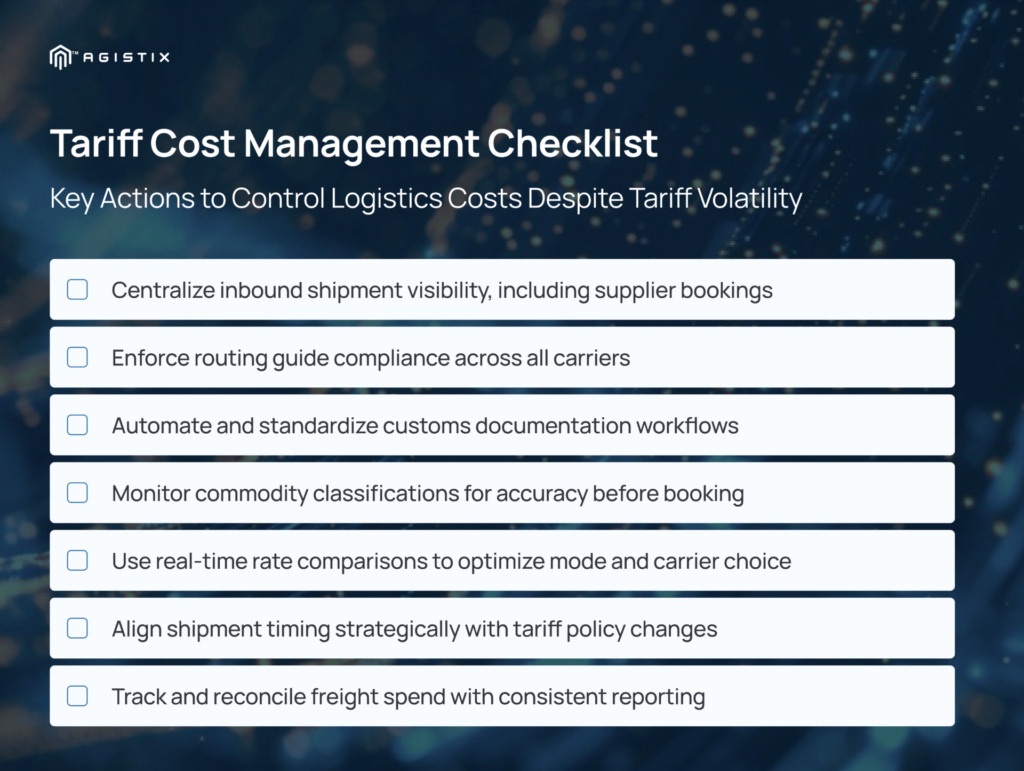June 16, 2025 - 8 minutes read

What Shippers Can Control: Practical Strategies to Offset Tariff Costs
Tariffs are a constant variable in global trade, and they’re rarely stable and frequently used as political leverage. For manufacturers and companies worldwide, that volatility translates into higher costs and greater uncertainty when moving goods across borders. A sudden increase in tariff and duty rates cuts into margins, complicates customer pricing, and disrupts even the most carefully planned supply chains.
Unfortunately, you can’t control the tariffs. But you can control how you respond to insulate your business and your profits against them.
An effective logistics strategy is critical to building resilience in the face of tariffs. By improving shipment planning, gaining earlier visibility into freight movements, and tightening operational execution, shippers can reduce avoidable costs and make better choices when timing and transportation decisions matter most.
This article outlines practical strategies to help logistics teams minimize the financial impact of tariffs by focusing on what they can control and using the right tools to do it.
Understanding tariff exposure in global logistics
Tariffs put pressure on cost centers across the supply chain, but the most damaging impacts often come from how shipments are planned, classified, and cleared. These operational issues expose companies to unnecessary fees and delays, leading to costs that could be avoided with better oversight.
To manage tariff-related risks effectively, logistics teams need to understand where exposure actually occurs:
- Import/Export Timing – Tariff rates are assessed based on clearance timing at the final destination. A shipment delayed by even a day may enter under a higher rate or face retroactive duty increases tied to changing policy. Poor scheduling or in-transit delays can lead to higher landed costs with little opportunity to mitigate them.
- Commodity Classification Errors – Inaccurate Harmonized Tariff Schedule (HTS) codes can trigger higher duty rates or invite scrutiny from customs authorities upon arrival. These classification errors often result in thousands of dollars in additional duties or post-entry audits.
- Documentation Inconsistencies – Quick customs clearance requires complete and accurate paperwork. Missing or mismatched data across commercial invoices, packing lists, and bills of lading often leads to shipment holds or additional fees that drive up total cost.
Understanding where tariff exposure occurs is only the first step. To minimize its financial impact, companies need to translate that insight into better logistics execution, starting with how shipments are routed and managed across internal systems and external partners.
Logistics strategies to offset the financial impact of tariffs
Even though tariff rates can’t be avoided, the financial impact often can, as long as logistics teams can get ahead with their response. The strategies below focus on improving shipment-level decisions and tightening operational control to reduce tariff-driven costs across the supply chain.

1. Enhance inbound and supplier visibility
Inbound visibility plays a critical role in tariff exposure, but most manufacturers simply don’t have it. Without accurate information about when international orders ship, how they’re routed, and when they’re set to arrive in the U.S., logistics teams are left guessing. And since tariff rates are based on arrival and clearance, those visibility gaps can become expensive.
Companies also face added risk when suppliers handle freight booking. If routing compliance isn’t maintained, or if suppliers book with slower or less reliable carriers, anticipated freight costs can increase with no room for negotiation. That’s why visibility is essential—not just after a shipment’s in motion, but at the moment it’s booked.
The most effective solutions provide centralized insight into all inbound orders, regardless of how or where they were booked. That includes supplier-arranged shipments, which are often the biggest blind spot in global transportation. Look for an inbound visibility platform that can:
- Automate status updates and accurate ETAs across all inbound shipments
- Provide visibility into supplier-booked freight to monitor routing and mode compliance
- Consolidate inbound data into one platform to reduce manual tracking across systems
- Trigger automated alerts when delays or exceptions put timing or cost at risk
2. Improve freight spend forecasting and budget control
Freight budgeting is much harder when data is fragmented. Without centralized, standardized cost data, logistics teams struggle to track actual spend, compare it against estimated charges, or identify cost drivers across carriers and modes. This can lead to more surprises and higher landed costs as tariffs change.
Consistent reporting across regions and transportation partners is key to improving forecasting accuracy. Data centralization helps teams analyze historical trends, account for variable tariff updates, and build a reliable view of spend by lane, mode, and service level. The right visibility and reporting tools allow logistics teams to:
- Compare estimated vs. actual charges across all shipments
- Track transportation costs by lane and service level to identify trends
- Support faster invoice reconciliation by automating charge verification against contracted rates
3. Manage import/export timing to reduce cost exposure
Tariffs and duties are applied based on arrival, but in volatile markets, arrival dates should always be considered estimates. Port congestion, delays in transshipment, or missed sailings can all push a shipment past the expected arrival and result in significantly higher import rates.
To minimize that kind of risk, logistics teams need to consider both the timing of departure and the expected arrival window. In some cases, holding a shipment to delay clearance can reduce cost. In others, expediting freight is the only way to avoid a higher rate. Either way, the timing needs to be tightly aligned with tariff policy and clearance requirements.
4. Optimize routing and carrier selection
When tariff changes are expected, many importers accelerate shipments to clear goods under a lower rate. That sudden demand puts pressure on container capacity, especially on high-volume trade lanes like China–U.S. As capacity tightens, carriers often raise rates or adjust sailing availability, leaving shippers with fewer options and higher costs if they can’t secure space early.
This is why routing compliance and carrier selection are essential. During periods of high demand, shippers need to rely on carriers that can execute reliably under pressure. If suppliers choose slower modes or bypass routing instructions, it becomes harder to maintain service levels or control costs, even under contract. To reduce risk, logistics teams need to:
- Enforce routing guide compliance across all shipments, including supplier-booked freight
- Define preferred carriers by lane based on performance, reliability, and customs experience
- Prioritize high-volume lanes where early bookings are essential to secure stable capacity and pricing
- Monitor routing exceptions and address them before they impact cost or timing
5. Improve shipment strategy with mode, speed, and market-based quotes
When contracted carriers can’t meet demand or won’t honor rates during high-volume periods, importers need to pivot quickly. That may mean shifting volumes to alternate carriers or relying on the spot market to secure space. These decisions are especially important when shipments are scheduled near tariff deadlines.
Having the ability to request spot quotes, compare service levels, and make cost-performance trade-offs in real time helps logistics teams respond to changing market conditions. Solutions should enable teams to:
- Send shipments to bid quickly with pre-qualified carriers
- Compare real-time rates across modes, carriers, and service levels
- Evaluate cost vs. transit time to make informed decisions under pressure
- Maintain a historical record of rate activity for compliance and cost analysis
6. Standardize documentation to avoid delays and penalties
Incomplete or inconsistent documentation is one of the most common causes of customs delays. When paperwork doesn’t match across systems, shipments can be held, re-inspected, or reclassified, resulting in higher costs and longer dwell times.
To avoid these issues, documentation workflows need to be both automated and standardized. Pulling shipment data directly into preformatted templates helps eliminate manual entry errors, ensures consistency across all documents, and accelerates handoff between stakeholders. Centralized platforms also make it easier to collect, validate, and share customs documents in real time, improving speed and accuracy at the point of clearance.
7. Ensure accurate commodity classification
Incorrect commodity codes can result in overpaid duties or delayed clearance, both of which add cost and disrupt delivery schedules. These issues often stem from inconsistent classification practices or outdated product data.
To avoid those problems, classification should be centralized and verified before booking. When linked directly to shipping documents, accurate classifications reduce the chance of customs disputes and help ensure smooth processing at the point of entry.
Turning strategy into action with Agistix
Tariffs introduce cost pressure that shippers can’t control, but how teams plan and execute transportation and logistics is entirely within their reach. The difference between absorbing those costs and avoiding them often comes down to visibility, timing, and reliable coordination across partners and systems.
Agistix brings these capabilities into a single platform built for logistics professionals managing complex, high-volume operations.
- Agistix Visibility provides a centralized view of inbound shipments, even those booked by suppliers, with accurate ETAs and cost data to support better planning and forecasting.
- Agistix TMS allows teams to compare rates, evaluate service levels, and make execution decisions based on current tariff timing and capacity conditions.
- Agistix Microsites simplify collaboration with internal and external stakeholders, making it easier to manage documentation, routing compliance, and shipment communication at scale.
Together, these tools give logistics teams what they need to act faster and avoid preventable costs. Instead of spending time chasing information, they can focus on executing strategies that control freight spend to better protect margins.
Ready to see how Agistix can help you manage cost exposure and take control of your logistics strategy? Schedule a demo to see the platform in action.
